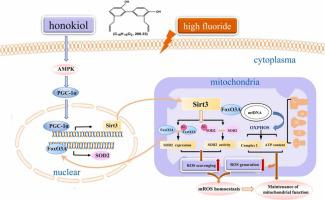Journal of Hazardous Materials ( IF 13.6 ) Pub Date : 2022-06-16 , DOI: 10.1016/j.jhazmat.2022.129381 Dongmei Wang 1 , Luyang Cao 1 , Xiang Zhou 1 , Gang Wang 1 , Yilu Ma 1 , Xueqin Hao 1 , Hua Fan 2

|
Oxidative stress and mitochondrial dysfunction contribute greatly to fluoride-induced cognitive impairment and behavioural disorders. Honokiol, a natural biphenolic compound, possesses antioxidant and mitochondrial protective properties. The present study investigated the protective actions of honokiol on NaF-elicited cognitive deficits and elucidated the possible mechanism of honokiol-mediated protection. The results demonstrated that honokiol administration markedly attenuated fluoride-induced cognitive impairments and neural/synaptic injury in mice. Moreover, honokiol elevated the activity and expression of SOD2 and promoted mtROS scavenging through Sirt3 activation in NaF-treated mice and SH-SY5Y cell lines. Meanwhile, honokiol substantially lowered mtROS production by enhancing Sirt3-mediated mitochondrial DNA (mtDNA) transcription, thereby leading to significant increases in ATP synthesis and complex I activity. Further studies revealed that honokiol activated AMPK and upregulated the PGC-1α and Sirt3 protein expression in vivo and in vitro. Intriguingly, the protective actions of honokiol on oxidative stress and mitochondrial dysfunction were abolished by AMPK shRNA or Sirt3 shRNA. Notably, AMPK knockdown prevented the increase in PGC-1α and Sirt3 expression induced by honokiol, while Sirt3 shRNA suppressed Sirt3 signaling without significant effects on p-AMPK and PGC-1α expression. In conclusion, our findings indicate that honokiol mitigates NaF-induced oxidative stress and mitochondrial dysfunction by regulating mtROS homeostasis, partly via the AMPK/PGC-1α/Sirt3 pathway, which ultimately contributes to neuronal/synaptic injury and cognitive deficits.
中文翻译:

通过激活 AMPK/PGC-1α/Sirt3 减轻和厚朴酚对氟化物诱导的线粒体氧化应激、线粒体功能障碍和认知缺陷的影响
氧化应激和线粒体功能障碍对氟化物引起的认知障碍和行为障碍有很大贡献。厚朴酚是一种天然双酚化合物,具有抗氧化和线粒体保护特性。本研究调查了和厚朴酚对 NaF 引起的认知缺陷的保护作用,并阐明了和厚朴酚介导的保护作用的可能机制。结果表明,和厚朴酚可显着减轻氟化物引起的小鼠认知障碍和神经/突触损伤。此外,和厚朴酚提高了 SOD2 的活性和表达,并通过在 NaF 处理的小鼠和 SH-SY5Y 细胞系中激活 Sirt3 促进 mtROS 清除。同时,和厚朴酚通过增强 Sirt3 介导的线粒体 DNA (mtDNA) 转录显着降低 mtROS 的产生,从而导致 ATP 合成和复合物 I 活性显着增加。进一步的研究表明,和厚朴酚激活 AMPK 并在体内和体外上调 PGC-1α 和 Sirt3 蛋白的表达。有趣的是,和厚朴酚对氧化应激和线粒体功能障碍的保护作用被 AMPK shRNA 或 Sirt3 shRNA 消除了。值得注意的是,AMPK敲低阻止了和厚朴诱导的PGC-1α和Sirt3表达增加,而Sirt3 shRNA抑制了Sirt3信号传导,对p-AMPK和PGC-1α表达没有显着影响。总之,我们的研究结果表明,和厚朴酚通过调节 mtROS 稳态来减轻 NaF 诱导的氧化应激和线粒体功能障碍,部分通过 AMPK/PGC-1α/Sirt3 途径,最终导致神经元/突触损伤和认知缺陷。



























 京公网安备 11010802027423号
京公网安备 11010802027423号